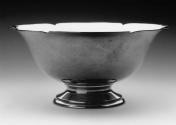Advanced Search
Bowl
Designed by: George Christian Gebelein (American, born in Germany, 1878–1945)
Gebelein Silversmiths (1908 to about 1960)
Gebelein Silversmiths (1908 to about 1960)
about 1930–40
Object Place: Boston, Massachusetts, United States
Medium/Technique
Silver
Dimensions
Overall: 9.8 x 21 cm (3 7/8 x 8 1/4 in.)
Credit Line
Gift of Mr. and Mrs. Herbert F. Sacks
Accession Number1992.386
NOT ON VIEW
CollectionsAmericas
ClassificationsSilver hollowware
In the 1920s to the mid-1940s, Gebelein enjoyed a good trade in copper bowls, partly due to the scarcity and subsequent prohibitive cost of silver. In addition to being more affordable than silver during the Depression, copper vessels may have been more popular in Boston because the corporate headquarters of Anaconda, a large copper mine, was located on Beacon Hill, and many Bostonians held shares in the company. During World War II, however, Gebelein’s production of copper wares all but ceased when wartime restrictions prevented artists from using the material.
According to Gebelein’s daughter Eleanor, who worked in the family’s retail store, copper pieces were common wedding presents for Beacon Hill brides. The shop promoted the firm’s copper line through brochures distributed locally and nationally. Appealing to a broad economic base, Gebelein offered a wide assortment of shapes and sizes while emphasizing copper’s innate qualities that “lend to home decoration that needed touch of color, and a certain feeling of hospitality which Copper of all metals alone imparts.” This bowl was item number F210 and is listed as a flower or fruit bowl that “has proved a favorite.” It was available with a regular or scalloped edge for $15; a hammered finish and silver lining were optional. Gebelein advertised his signature bowls as distinctive from other copperwares since the silver lining rendered them more inert and thus more practical for everyday use. The shop marketed this ware as having a classic, yet modern, modified Revere style.
Although Gebelein marketed his work as “hand-wrought,” much of it was made mechanically. The shop regularly contracted spinning work to a Boston South End spinner named Harry Allen and to Eastern Spinning, a Malden firm. Thus, most copper bowls were fully formed when they arrived at the Gebelein shop, where assistants lightly hammered them to eliminate the spinning marks, to harden the copper, and, above all, to impart a handmade look. Ornamental details and the Gebelein touchmark were added then as well. Silver-lined bowls were individually plated in the Gebelein shop through an electroplating process that required two to three hours on average. The bowl received the last “coloring” polish, without diminishing the hammer marks, and the piece was prepared for shipment or sale in the shop.
This text has been adapted from "Silver of the Americas, 1600-2000," edited by Jeannine Falino and Gerald W.R. Ward, published in 2008 by the MFA. Complete references can be found in that publication.
According to Gebelein’s daughter Eleanor, who worked in the family’s retail store, copper pieces were common wedding presents for Beacon Hill brides. The shop promoted the firm’s copper line through brochures distributed locally and nationally. Appealing to a broad economic base, Gebelein offered a wide assortment of shapes and sizes while emphasizing copper’s innate qualities that “lend to home decoration that needed touch of color, and a certain feeling of hospitality which Copper of all metals alone imparts.” This bowl was item number F210 and is listed as a flower or fruit bowl that “has proved a favorite.” It was available with a regular or scalloped edge for $15; a hammered finish and silver lining were optional. Gebelein advertised his signature bowls as distinctive from other copperwares since the silver lining rendered them more inert and thus more practical for everyday use. The shop marketed this ware as having a classic, yet modern, modified Revere style.
Although Gebelein marketed his work as “hand-wrought,” much of it was made mechanically. The shop regularly contracted spinning work to a Boston South End spinner named Harry Allen and to Eastern Spinning, a Malden firm. Thus, most copper bowls were fully formed when they arrived at the Gebelein shop, where assistants lightly hammered them to eliminate the spinning marks, to harden the copper, and, above all, to impart a handmade look. Ornamental details and the Gebelein touchmark were added then as well. Silver-lined bowls were individually plated in the Gebelein shop through an electroplating process that required two to three hours on average. The bowl received the last “coloring” polish, without diminishing the hammer marks, and the piece was prepared for shipment or sale in the shop.
This text has been adapted from "Silver of the Americas, 1600-2000," edited by Jeannine Falino and Gerald W.R. Ward, published in 2008 by the MFA. Complete references can be found in that publication.
DescriptionThe scallop-edged copper bowl has a spun and hammered body and spun applied foot. The silver lining was applied by an electroplating technique that enhanced the hammered appearance.
Marks
“GEBELEIN” in a rectangle and “Boston” struck incuse on bottom. “F 1439” scratched on bottom, above marks.
InscriptionsNone.
ProvenanceOriginal owner unknown; purchased privately by the donors, Mr. and Mrs. Herbert F. Sacks, at auction in the 1980s.



